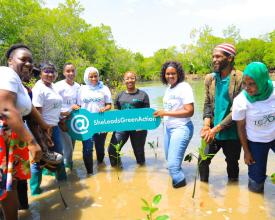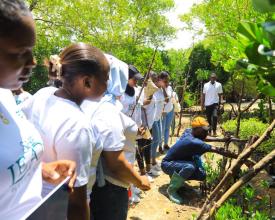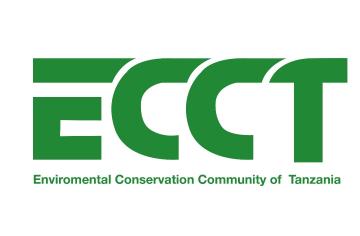
She Leads Green Action Program:Empowering young women to address climate change challenges in Tanzania
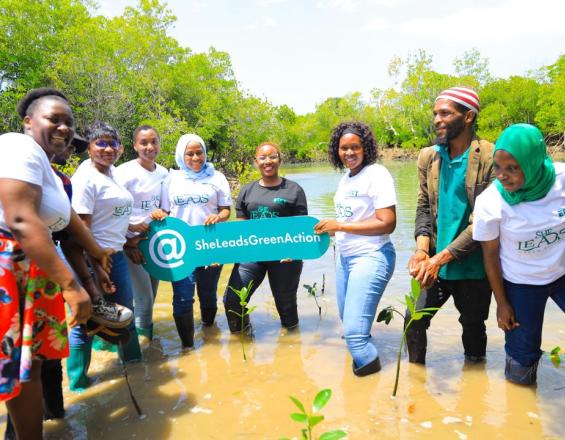
The She Leads Green Action Program (SLGAP) offers women aged 18-35 a six-week immersive experience focused on green actions and environmental sustainability. Through workshops, field trips, and hands-on projects, participants learn about the environment and how they can promote gender equality and lead sustainable actions.
Since its launch in June 2022, SLGAP has trained two cohorts of 60 women, providing them with leadership skills, climate change knowledge, and entrepreneurial tools to foster sustainable development. A major achievement is the rehabilitation of over 1,000 mangroves in Kunduchi Mtongani, enhancing coastal resilience.
The program has also inspired the creation of five women-led social businesses in sustainable agriculture, eco-products, and renewable energy. Additionally, 10 products and prototypes with scale-up potential have been developed, contributing to environmental and economic sustainability.
A strong alumni network ensures continued support through mentorship, coaching, and networking.
Context
Challenges addressed
Climate change disproportionately affects women due to gender-related factors like inequality, roles, socioeconomic norms, and policies. Its impact is particularly evident in climate-sensitive sectors such as agriculture, water, fisheries, and health. Despite this, many developing countries, including Tanzania, lack gender-responsive climate-action plans. While gender equality is a basic human right and vital for sustainable development, gaps persist, with women, young girls, and marginalised groups bearing the brunt of climate impacts.
Globally, women, who make up 43% of the agricultural workforce, have less access to land, credit, and inputs, limiting their climate adaptation. Women are often excluded from climate decision-making, reducing their capacity to cope with its effects. In Tanzania, climate change costs around 1% of GDP annually, potentially rising to 3% by 2030, with women disproportionately affected.
The She Leads Green Action program addresses these challenges by training women in sustainable practices.
Location
Process
Summary of the process
Wanting women at the forefront of mangrove restoration requires them to receive training and capacity building so as to be well quipped with knowledge and the ability to inspire others to join this initiative.
Building Blocks
Women at the forefront of Mangrove restoration to inspire more people to join mangrove conservation efforts.
Women face multifaceted challenges that hinder their active participation in climate change mitigation and environmental sustainability. These include limited access to financial capital and technology, heightened vulnerability to climate change impacts, limited education and awareness, gender-based discrimination, and restricted entry into leadership roles. Additionally, women's access to markets and capital is constrained by gender roles, insufficient skills, resources, and mobility.
Enabling factors
Working together with coastal communities, fishermen and the Beach Management Unit (BMU) in Dar Es Salaam, also through our local partners, Aqua Farm Organization (AFO), Girls in Climate Change (GICC) and Tanzania Forestry Service.
Meeting with the local leaders to be able to work closely with the young women in the community.
Carried out research on the challenges that were impacting the mangroves and issues causing the lack of conservation of the mangroves by the coastal communities.
Ensured community ownership in this process, so that the women feel they are a part of the solution and are willing to volunteer in these conservation efforts.
Lesson learned
Women’s involvement in mangrove conservation is a vital tool for empowering women to feel they are part of the solution and can take on more leadership roles in environmental conservation.
Involving community members before project implementation is crucial, they feel more mob to be part of the process and adds value to project implementation
Training and capacity building with women in the community
This building block focuses on empowering women in local communities through targeted training and capacity-building initiatives. The aim is to equip women with essential skills, knowledge, and resources to engage in sustainable practices, environmental conservation, and climate change mitigation. By fostering leadership and entrepreneurial abilities, women can play a pivotal role in driving positive change in their communities and contributing to broader socio-economic development.
Enabling factors
- Collaboration with local leaders and organisations for community engagement.
- Access to resources, tools, and technology that enhance training programs.
- Inclusion of gender-sensitive approaches in curriculum design.
- Continuous mentorship and follow-up support for sustained impact.
- Financial and institutional support from government and NGOs
Lesson learned
- Tailored training programs that address the specific needs and contexts of women are more effective.
- Building trust and community ownership leads to greater participation.
- Ongoing support is essential to ensure long-term success and capacity retention.
- Encouraging peer-to-peer learning boosts confidence and leadership among participants.
Impacts
Environmental Impacts:
- Biodiversity Enhancement: Restoration efforts have increased local biodiversity by 30%, creating habitats for marine and terrestrial species, including a resurgence in fish populations.
- Carbon Sequestration: Restored mangroves sequester approximately 1,200 metric tons of CO₂ annually, aiding climate change mitigation.
- Coastal Protection: Mangroves reduce erosion by 50%, providing natural barriers against storm surges and flooding, safeguarding communities.
- Water Quality Improvement: Restoration activities have reduced sediment and nutrient runoff by 25%, improving water quality and supporting local fisheries.
- Soil Stabilisation: Mangrove roots have stabilised soil, reducing land degradation by 40% and maintaining ecosystem health.
Social Impacts:
- Empowerment of Young Girls: The program trained 60 girls, fostering eco-leadership, with 15% launching their own environmental initiatives.
- Community Engagement: Over 150 community members participated, enhancing cohesion and collective responsibility for conservation.
- Increased Awareness: Environmental awareness among residents has risen by 60%, promoting sustainable practices.
Economic Impacts:
- Improved Livelihoods: Fishermen reported a 20% increase in catches, boosting food security and incomes for 50+ families.
- Eco-Tourism Development: The restored areas attracted eco-tourism, generating significant revenue for the local community
Beneficiaries
Local Communities
Fishermen
Young girls and women
Local Ecosystems
Sustainable Development Goals
Story
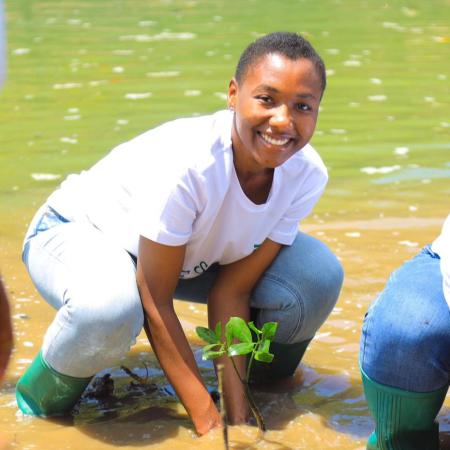
Alice-Anna Shoo, a passionate young woman, embarked on a trans-formative journey through the She Leads Green Action program. Initially, she faced challenges in understanding environmental issues and lacked entrepreneurial skills to address them. However, her determination to make a difference led her to this initiative, where she gained invaluable knowledge in environmental conservation, eco-entrepreneurship, and leadership.
During the program, Alice-Anna received comprehensive training that empowered her to identify environmental challenges in her community. She learned about sustainable practices, biodiversity, and the role of eco-entrepreneurship in driving change. Inspired by her newfound skills, she envisioned impactful solutions.
Alice-Anna recognised the need for mangrove restoration in the Ocean Shores area. Aware of the critical role mangroves play in coastal resilience and biodiversity, she developed a project to restore these vital ecosystems. With her training from She Leads Green Action, she crafted a detailed plan to engage her community in replanting mangroves, raising awareness about their importance, and promoting sustainable coastal practices.
She launched workshops to teach local residents about sustainable living and the significance of preserving natural surroundings, including mangroves. Through dedication and collaboration, Alice-Anna successfully implemented her project, gaining support from local stakeholders and inspiring others to join the cause. Her initiative not only addressed environmental challenges but also fostered community involvement and awareness.
Today, Alice-Anna is a model eco-entrepreneur, demonstrating how knowledge and leadership can create lasting change. Her success is a testament to the She Leads Green Action program’s role in nurturing future environmental leaders. Her continued commitment to restoring the environment and advocating for sustainability inspires others, proving that with the right tools and support, young women can lead trans-formative change in their communities.
